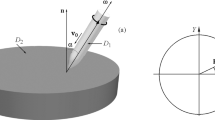Abstract
An analysis is made of experimental results on impact (at velocities of 0.6–6.26 km/sec) of projectiles made of Caprolon and polyethylene and compound projectiles (made of Caprolon with steel or aluminum spheres) on targets made of an epoxy resin with and without a filler (Al2O3) in a ballistic range. Impact on the edge surface of cylindrical targets with a characteristic size of 0.05 m is investigated. Complete fracture of the targets was recorded at velocities above 1 km/sec. The masses and dimensions of the collected fragments are subjected to statistical analysis. Average values of the fragment sizes and specific surface fracture energy are calculated.
Similar content being viewed by others
References
B. L. Glushak, V. F. Kuropatenko, and S. A. Novikov, Strength of Materials under Dynamic Loading [in Russian], Nauka, Novosibirsk (1992).
G. I. Kanel’, S. V. Razorenov, A. V. Utkin, and V. E. Fortov, Shock-Wave Phenomena in Condensed Media [in Russian], Yanus-K, Moscow (1996).
V. M. Fomin, A. I. Gulidov, G. A. Sapozhnikov, et al., High-Velocity Interaction [in Russian], Izd. Sib. Otd. Ross. Akad. Nauk, Novosibirsk (1999).
L. V. Al’tshuler, R. F. Trunin, V. D. Urlin, et al., “Development of dynamic methods for high-pressure research in Russia,” Usp. Fiz. Nauk, 169, No. 2, 323–344 (1999).
R. Kinslow (ed.), High-Velocity Impact Phenomena, Academic Press, New York-London (1970).
B. L. Strauss, “New ablative heat shield materials for mars landers,” J. Spacecraft Rockets, 4, No. 10, 1304–1309 (1967).
N. N. Pilyugin, “Determining the velocities of sticking of electrons to aluminum oxides from ballistic experiments,” Teplofiz. Vysok. Temp., 32, No. 3, 339–353 (1994).
A. N. Pilyugin and N. N. Pilyugin, “Determining the rate constants of recombination and sticking reactions from ballistic experiments,” Combust., Expl., Shock Waves, 31, No. 5, 70–82 (1995).
N. N. Pilyugin, “Sticking velocities of electrons to aluminum oxides in mixtures of air with xenon,” Combust., Expl., Shock Waves, 41, No. 3, 65–73 (2005).
N. N. Pilyugin, “Laboratory determination of the rate constant of silicon ion recombination: Applications to studies of a meteoric trace,” Astronom. Vestn., 31, No. 6, 550–557 (1997).
P. V. Kozlov, S. V. Kochergin-Nikitskii, and N. N. Pilyugin, “Fracture of polymer materials under high-velocity impact,” in: Abstracts of IX All-Union Congress on the Theoretical and Applied Mechanics, Vol. 3, Lobachevskii Nizhegorod. Gos. Univ., Novgorod (2006), pp. 112–113.
D. Kerren, D. Shocky, L. Simen, and M. Ostin, “Mechanisms and models of crater formation in environment,” in: Impact, Explosion and Fracture [Russian translation], Mir, 1981, pp. 81–115.
A. Fujiwara, “Results obtained by laboratory simulations of catastrophic impact,” Memore S. A. It., 57, No. 1, 47–63 (1986).
G. S. Khodakov, Physics of Grinding [in Russian], Nauka, Moscow (1972).
A. N. Kolmogorov, “Lognormal law of distribution of particle sizes in grinding,” Dokl. Akad. Nauk, SSSR, 31, No. 2 (1942).
J. J. Gilvary, “Fracture of brittle solids,” J. Appl. Phys., 32, No. 3 (1961).
L. I. Baron and I. E. Hmelkovskii, Rock Breaking by Free Impact [in Russian], Nauka, Moscow (1971).
É. A. Koshelev, V. M. Kuznetsov, S. G. Sofronov, and A. G. Chernikov, “Statistics of fragments formed during fracture of solids by explosion,” J. Appl. Mech. Tech. Phys., No. 2, 87–100 (1971).
V. A. Odintsov, “Bimodal distribution of fragments of cylinders,” Combust., Expl., Shock Waves, 27, No. 5, 118–122 (1991).
V. A. Odintsov, “Hyperexponential spectra of explosive destruction of metal cylinders,” Mekh. Tverd. Tela, No. 5, 48–55 (1992).
F. Kun, F. K. Wittel, H. J. Herrmann, B. H. Kroplin, and K. J. Maloy, “Scaling behavior of fragment shapes,” Phys. Rev. Lett., No. 96, 025504, 1–4 (2006).
A. B. Kiselev, “Model of fragmentation during high-velocity collision of particles of space dust,” Vestnik Mosk. Univ., Ser. 1, Mat., Mekh., No. 3, 50–55 (2001).
W. K. Brown and K. H. Wohletz, “Derivation of the Weibull distribution based on physical principles and its connection to the Rosin-Rammler and lognormal distributions,” J. Appl. Phys., No. 78(4), 2758–2763 (1995).
H. Melosh, Impact Cratering. A Geological Process, Oxford University Press-Clarendon Press, Oxford-New York (1989).
D. E. Munson, R. R. Boade, and K. W. Schuler, “Stress-wave propagation in Al2O3-epoxy mixtures,” J. Appl. Phys., 49, No. 9, 797–807 (1978).
G. P. Cherepanov, Mechanics of Brittle Fracture [in Russian], Nauka, Moscow (1974).
Author information
Authors and Affiliations
Corresponding author
Additional information
__________
Translated from Fizika Goreniya i Vzryva, Vol. 44, No. 2, pp. 129–138, March–April, 2008.
Rights and permissions
About this article
Cite this article
Pilyugin, N.N. Destruction of filled polymer targets by high-velocity impact. Combust Explos Shock Waves 44, 239–247 (2008). https://doi.org/10.1007/s10573-008-0031-z
Received:
Issue Date:
DOI: https://doi.org/10.1007/s10573-008-0031-z




